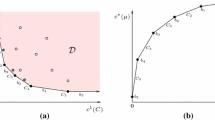Abstract
In this paper we address the problem of finding a dominator for a multiple-objective maximization problem with quasiconvex functions. The one-dimensional case is discussed in some detail, showing how a Branch-and-Bound procedure leads to a dominator with certain minimality properties. Then, the well-known result stating that the set of vertices of a polytope S contains an optimal solution for single-objective quasiconvex maximization problems is extended to multiple-objective problems, showing that, under upper-semicontinuity assumptions, the set of (k 21)-dimensional faces is a dominator for k-objective problems. In particular, for biobjective quasiconvex problems on a polytope S, the edges of S constitute a dominator, from which a dominator with minimality properties can be extracted by Branch-and Bound methods.
Similar content being viewed by others
References
Avriel, M., Diewert, W.E., Schaible, S. and Zang, I. (1988), Generalized Concavity, Plenum Press, New York /London.
Blanquero, R. (1999), Localizaciön de servicios en el plano mediante técnicas de optimizacion d.c. Unpublished Ph.D., Universidad de Sevilla, Spain.
Carrizosa, E., Conde, E., Muñoz, M. and Puerto, J. (1995), Planar point-objective location problems with nonconvex constraints: a geometrical construction. Journal of Global Optimization 6: 77-86.
Carrizosa, E., Conde, E. and Romero-Morales, D. (1997), Location of a semiobnoxious facility. A biobjective approach. In Advances in Multiple Objective and Goal Programming. Lecture Notes in Economics and Math. Systems 455, Springer, Berlin, 274-281.
Carrizosa, E. and Frenk, J.B.G. (1998), Dominating sets for convex functions with some applications. Journal of Optimization Theory and Applications 96: 281-295.
Carrizosa, E. and Plastria, F. (1999), Location of semi-obnoxious facilities. Studies in Locational Analysis 12: 1-27.
Chankong, V. and Haimes, Y. (1983), Multiobjective Decision Making, North-Holland.
Das, I. and Dennis, J.E. (1998), Normal-Boundary Intersection: A New Method for Generating the Pareto Surface in Nonlinear Multicriteria Optimization Problems. SIAM J. on Optimization 8: 631-657.
Durier, R. (1990), On Pareto optima, the Fermat-Weber problem and polyhedral gauges, Mathematical Programming 47: 65-79.
Durier, R. and Michelot, C. (1985), Geometrical Properties of the Fermat-Weber problem, European Journal of Operational Research 20: 332-343.
Erkut, E. and Neuman, S. (1989), Analytical Models for Locating Undesirable Facilities, European Journal of Operational Research 40: 275-291.
Hansen, P., Jaumard, B. and Lu, S.H. (1992), Global optimization of univariate Lipschitz functions. II. New algorithms and computational comparison. Mathematical Programming 55: 273-292.
Hansen, P., Peeters, D., Richard, D. and Thisse, J.F. (1985), The minisum and mimimax location problems revisited. Operations Research 33: 125-126.
Hansen, P. and Thisse, J.F. (1981), The Generalized Weber-Rawls Problem, Operations Research (J.P. Brans, ed.). North Holland, pp. 487-495.
Horst, R. and Tuy, H. (1990), Global Optimization. Deterministic Approaches. Springer-Verlag.
Kuhn, H.W. (1967), On a pair of dual nonlinear programs, in J. Abadie (ed.), Methods of Nonlinear Programming. North-Holland, pp. 37-54.
Love, R.F., Morris, J.G. and Wesolowsky, G.O. (1988), Facilities location: models and methods, North-Holland, New York.
Mateos, A. and Ríos-Insua, S. (1996), Utility efficiency and its approximation. Top 4: 285-299.
Michelot, C. (1993), The mathematics of Continuous Location, Studies in Locational Analysis 5: 59-83.
Okabe, A., Boots, B. and Sugihara, K. (1992), Spatial tesselations. Concepts and applications of Voronoi diagrams. Wiley.
Plastria, F. (1983), Continuous location problems and cutting plane algorithms, Ph.D. dissertation, Vrije Universiteit Brussel, Brussels.
Plastria, F. (1984), Localization in single facility location, European Journal of Operational Research 18: 215-219.
Plastria, F. (1995), Continuous Location Problems, in Facility Location: A Survey of Applications and Methods, Springer-Verlag, New York, pp. 225-262.
Plastria, F. (1996), Optimal location of undesirable facilities: A selective overview, JORBEL: Belgian Journal of Operations Research, Statistics and Computer Science 36: 109-127.
Plastria, F. and Carrizosa, E. (1999), On gauges and median hyperplanes. Working paper BEIF/112. Vrije Universiteit Brussel, Brussels, Belgium.
Preparata, F.P. and Shamos, M.I. (1985), Computational Geometry — An Introduction, Springer Verlag.
Schaible, S. (1995), Fractional Programming, in R. Horst and P.M. Pardalos (eds.), Handbook of Global Optimization, Kluwer.
Steuer, R. (1986), Multiple criteria optimization: Theory, Computation, Application, Wiley.
Thisse, J.F., Ward, J.E. and Wendell, R.E. (1984), Some Properties of Location Problems with Block and Round Norms, Operations Research 32: 1309-1327.
Wendell, R.E. and Hurter, A.P. (1973), Location theory, dominance, and convexity, Operations Research 21: 314-320.
White, D.J. (1982), Optimality and Efficiency. Wiley.
Author information
Authors and Affiliations
Rights and permissions
About this article
Cite this article
CARRIZOSA, E., PLASTRIA, F. Dominators for Multiple-objective Quasiconvex Maximization Problems. Journal of Global Optimization 18, 35–58 (2000). https://doi.org/10.1023/A:1008312004757
Issue Date:
DOI: https://doi.org/10.1023/A:1008312004757




